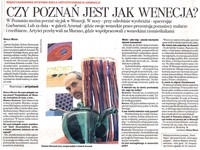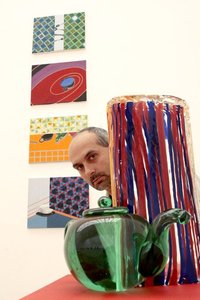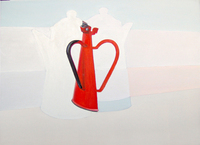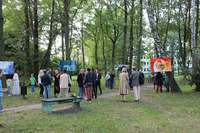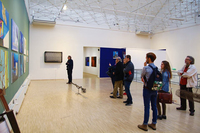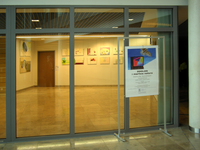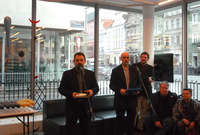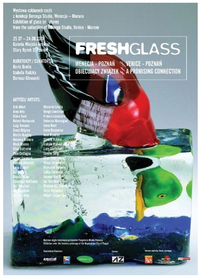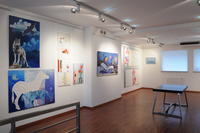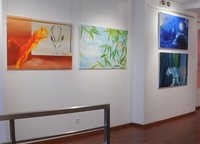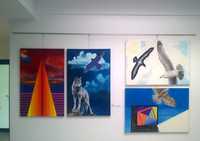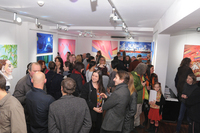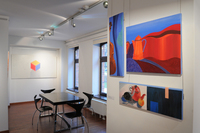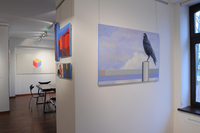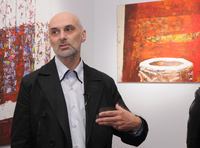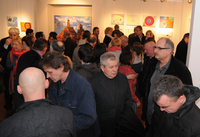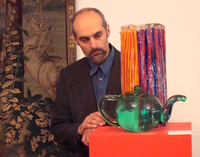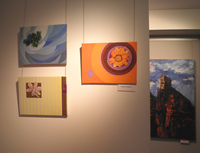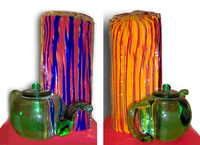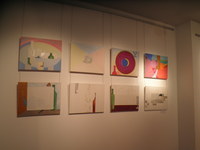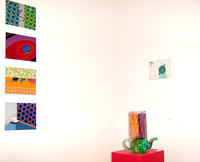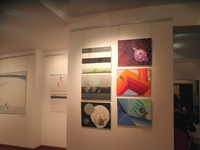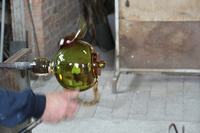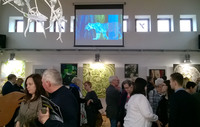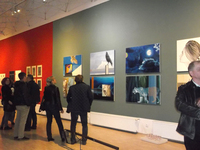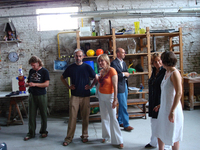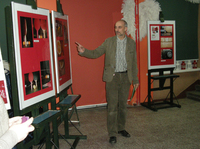Dariusz Głowacki CV
Urodzony w 1965 roku w Poznaniu w Polsce.
2012: Obrona pracy doktorskiej na Uniwersytecie Artystycznym w Poznaniu na Wydziale Malarstwa.
1989-1990: Stypendium Ministra Kultury i Sztuki dla najbardziej obiecujących młodych artystów.
1984-1989: Ukończenie studiów magisterskich na Akademii Sztuk pięknych w Poznaniu. Dyplom z wyróżnieniem na wydziałach Malarstwa i Wychowania Plastycznego. Dyplom z malarstwa w pracowni prof. Jerzego Kałuckiego pod kierunkiem prof. Jarosława Kozłowskiego, dyplom z zakresu semiotyki na Wydziale Wychowania Plastycznego pod przewodnictwem prof. Kazimierza Świrydowicza.
1980-1984: V Liceum Ogólnokształcące w Poznaniu.
Dariusz Głowacki zajmuje się malarstwem, rysunkiem, tworzeniem obiektów w przestrzeni, pisze i publikuje teksty o kulturze i sztuce. Prowadzi także wykłady o sztuce i szeroko pojmowanej kulturze wizualnej.
Działa również jako kurator (m.in. wystawy: szkła weneckiego „Fresh Glass” w 2008, Światło² w 2015, PozaPOZNANIEM 2016).
Interesują go obszary, na których sztuka spotyka się z nauką, a także różnice, które zdają się dzielić obie domeny działalności człowieka.
Uczestnik sesji naukowych, paneli dyskusyjnych i kongresów (m.in. Sztuka – Nauka w 2014 r. i THE SECOND WORLD CONGRESS ON ANALOGY w 2017 r.)
Desperacko i naiwnie wierzy w sztukę.
Desperacko i naiwnie wierzy w sztukę.
Dariusz Głowacki CV
Born in 1965 in Poznan in Poland.
2012: PhD at The Uniwersity of Arts in Poznan at the FACULTY OF PAINTING.
1989-1990: Scolarship of the The Ministry of Culture and Arts for the most promising young arists.
1984-1989: MA/Jerzy Kałucki and Jaroslaw Kozlowski at the FACULTY OF PAINTING and MA/Kazimierz Świrydowicz of smiotics at the FACULTY OF ARTISTIC EDUCATION.
1980-1984: National Education High School nr 5
Dariusz Glowacki is an artist who paints, makes drawings, installations. He writes texts on arts and culture and lectures on art and broadly understood visual culture.
He also acts as a curator (including exhibitions: Venetian glass "Fresh Glass" in 2008,, Światło² in 2015, PozaPOZNANIEM in 2016).
He is interested in areas where art meets science, as well as differences that seem to divide both domains of human activity.
Participant in scientific sessions, discussion panels and congresses (including Art - Science in 2014 and THE SECOND WORLD CONGRESS ON ANALOGY in 2017).
Believes in art desperately and naively.
Obrazy Dariusza Głowackiego
“...Oglądając obrazy... wraz z ich tautologicznymi tytułami nie mam wątpliwości, podążamy w kierunku pytań najistotniejszych: czym jest przedmiot, czym jest rzecz, którą widzimy? Autor udziela odpowiedzi środkami malarskimi. Nie ufa naukowym wyjaśnieniom. Zresztą akt widzenia wciąż pozostaje nie do końca przejrzysty dla nauki, mimo rozwoju neuroestetyki i najnowszych technologii. Głowacki stawia „rzecz” w centrum swoich zainteresowań. Kryje się jednak za tym wyraźna ambiwalencja. Z jednej strony owa rzecz zakreśla krąg zainteresowań i poszukiwań, a z drugiej strony zatraca ona swoją znaczeniowość w kontekście całej tkanki obrazu. Staje się rzeczą konkretną w takim sensie, w jakim konkretność rozumiana była w sztuce. Konkretność, czyli swego rodzaju autoteliczność, autoreferencyjność, odniesie do samej siebie.
Wielokrotne, kompulsywne wręcz powtarzanie realistycznego widoku butelki, łyżeczki, kubka powoduje całkowitą utratę jej powszechnych warstw semantycznych. Jest przewrotnym porzuceniem powierzchownej realności, spod której prześwitują ich prawdziwe ontyczne jakości. W sztuce możliwe są takie przeistoczenia. Przywołanie i powtarzanie pełnej atrybucji jednej rzeczy powoduje jej specyficzną transcendencję poza językową semantyczność..."
Daria Milecka,
profesor nadzwyczajny
w Akademii Sztuk Pięknych we Wrocławiu
Światy Dariusza Głowackiego
"...Autor podąża w kierunku coraz to większej lapidarności, nawet jeżeli obraz jest „rozbity” tworzy wrażenie jego syntezy. Zwykłe przedmioty - kubki, talerze, sztućce, dzbanki … towarzyszą prawie każdemu spotkaniu i rozmowie, pełne j urywanych zdań i niedokończonych myśli i zapewne stąd wynika sposób kadrowania i komponowania niektórych jego obrazów.
Artysta powołuje do istnienia zagadkowe, przemieszczone światy, układa przemyślane sytuacje. Czasami dezorientują one widza,
oddalają od naszych przyzwyczajeń i postrzegania, pozwalają na wielość oglądów i spotkań z nimi...
Nie jest to typowy język obrazowania martwych natur. Stajemy w obliczu dzieł, które sytuują się w opozycji względem tego, co nam jest bliskie w obcowaniu, z obrazami obiektywnie danej nam rzeczywistości. Prace przedstawiają to co wyobraźnia interpretuje jako spostrzeżenie, to co jest jednością przeżycia intelektualnego i emocjonalnego..."
Anna Goebel
profesor zwyczajny
Uniwersytetu Artystycznego w Poznaniu
Malarstwo Dariusza Głowackiego
“...Malarstwo Dariusza Głowackiego jest bowiem zjawiskiem wyjątkowym, jest malarstwem fusion, zaskakująco udaną kompilacją malarstwa realistycznego z obrazowaniem abstrakcyjnym. Głowacki zbudował z nich wspólną jakość, połączył dwa radykalnie różne wektory sztuki, w jeden nowy twór, odnajdując własny sposób na ich wspólną, jednocześnie szlachetną, koegzystencję w przestrzeni j dzieła.
Czy w świecie rzeczywistym możliwe byłoby spotkanie Jeana Chardina z Frankiem
Stella?
W świecie artystycznej iluzji tak, pod warunkiem, że reżyserem tego spotkania będzie
Dariusz Głowacki...”
Jerzy Hejnowicz
profesor zwyczajny
Uniwersytetu Artystycznego w Poznaniu
Dariusz Glowacki's painting
“...Paintings by Dariusz Głowacki are a unique phenomenon which could be called fusion painting, a surprisingly successful compilation of realist painting with abstract works. Głowacki has built a shared quality using them both by combining two radically different art vectors into one new formation, nding his own way of achieving their noble coexistence in the work’s space.
– Could Jean Chardin meet Frank Stella in the real world?
Such a meeting could be possible in the world of illusion, provided it was arranged
by Dariusz Głowacki...”
Jerzy Hejnowicz,
Professor, Poznań University of Art
A painting is better than a word
Stein Nerland: First, the formal part of your paintings; your struggle to repeat the physical shape of the objects as we see them - why is this important to you?
Dariusz Głowacki: In the visual arts we always refer to real objects. Even the abstract paintings somehow touch them. In my case I want to come as close to objects as possible and needed. I try to tame or touch the objects of everyday life by painting them. The realistic painting I practise is somehow a kind of personal honesty and credibility. Perhaps it is only a temporary period in my work. Of course the result is only an illusion. You cannot copy nature by paints. On the other hand what you perceive in real life is only our brain projection based on limited senses. Let's say the struggle to repeat a physical shape of an object is only a beginning of a picture's life.
Stein Nerland: I know you read a lot. I want to ask about Phillip K. Dick. Surly it is not easy to capture his writing in a few words, but to me it seems his struggle was concerned about one major topic; what is real? And this leads me to your paintings in essence. You question the very same - but in visual terms. But not being able to copy nature by painting - surly the outspring gives a common ground. How can reality or so called reality - be questioned with paintings?
Dariusz Głowacki: Surely the question "what is real?" is my question as well. In our culture it is perhaps one of the most stimulating one. It exists in prehistoric paintings of amazed bison hunters, philosophy, science, and in present pop movies as well.
However instead of the question “what is reality” I am more absorbed by the questions “How does it work, what is its structure?”.
In realistic paintings I refer to visual appearance of an object and it is an attempt to imitate it. Somehow it resembles rational thinking which tries to introduce an order that is based on words, to embrace reality. The realistic painting and rational thinking are like tools to open doors of perception. But if you open them you enter an area where the tools are useless. Very quickly you learn about their limits and borders and they are not functional anymore. You face the unknown and all you have there is an ability to listen to, to watch. If you are open-eared, open-eyed, wide awake you have a little chance to touch something unusual, something that escapes words. I suppose it is like creating music. You have a melody or rhythm in the beginning and you enjoy following it.
When I paint I don't start with an idea to illustrate. I find an object that attracts me. I want to observe and investigate it. I don't know the reason I choose some objects but I suppose that the most important is the emotional part of it. When painting I always involve emotions. They reflect my perception of the world. Hope you find feelings and emotions in my paintings. They are always present; fear, joke, pain, yearning, love or game. They hide or reveal reality. It is something extremely paradoxical we use words towards paintings. I don't trust words. They seem to offer precise meaning but narrow down and conventionalize.
The moment I discovered Philip K. Dick I felt very familiar with his way of using words in purpose to touch "so called reality". Every period of history has its workers to built culture. PKD is probably the most amazing example in American culture. Naming PKD a Dostoyevsky of science-fiction is a good idea, though I hardly see any science-fiction in his writings.
Stein Nerland: Even though your approach (paradoxical, and not to be trusted) towards the descriptive words concerning your paintings, which cultural roots are important to you?
Dariusz Głowacki: Well, all of them. I consume almost all kinds of music. From Bach and Coltrane to roc. In literature I appreciate very: PKD, Ernst Junger, Samuel Beckett, Yukio Mishima, Michel Houellebecq, Thomas Pynchon to mention a few. The visual arts offer so many things. We have also movies and Luis Bunuel, Werner Herzog, David Lynch. When considering science I am absorbed by quantum mechanisc, semiotics, and in non-science: Carl Gustav Jung psychology and religious thinking of Master Eckhart. The world surprises me almost everyday I still discover something new in culture.
Stein Nerland: Can you tell me about painting “disappeared”?
Dariusz Głowacki: I think that towards reality and art we have only a personal interpretation of it. In case of “disappeared” the idea came from observing an object. When I moved it a little on my desk it started a question what happened with a space it was in before and what space the object creates after the move, reappearing. Sounds confusing but I have doubts about relations between objects and space. What happens with a space that was occupied by something? Does a taken object own it something and hold something of it? What area does it enter when put into other place? And does it change it? You see many more or less foolish questions. I think that a picture does it much better then word.
Oslo-Lubon 2008
Everyday life and Dariusz Glowacki’s paintings
Undoubtedly the pictures he paint can be classified as Still Life. Many of them show things taken from everyday life. In the pictures you may find: cups, plates, knives, forks, spoons or teapots. In the past he used to create installations where similar objects were also present. For many years however he has been focused rather on oil painting.
The objects in his pictures are painted in a realistic, almost illusive way. They seem to be concrete and naturalistic. The most important difference between his paintings and traditional Still Life can be found in the way the background of the objects was painted. The background is always abstract. It is either a pure colour or a surface consisting of abstract forms and shapes. Objects of the daily life are painted in a realistic manner buy they are usually incomplete, deficient or cut. Some of their fragments are missing or the objects seem to escape the pictures. You may also find some resemblances to Surrealistic pictures. The tradition of Surrealism is inspiring for him because of some formal solutions introduced by painters like Salvador Dali or Rene Magritte. We must admit that he owes much more to abstract art, especially for east European painters like Kazimierz Malewicz, Wasyl Kandinsky or Henryk Stażewski. In the abstract art he is interested in the manner the mentioned above artists created rhythms of forms and colours. For other reasons he admires the art of Giorgio Morandi and Henri Matisse. The first one for the silence in his pictures and the second one for an opposite reason, the musical and joyful ambience. When looking for roots of his paintings we cannot forget about his experience with installations and three dimensional objects. The experience let him remember about some questions referring to space and to the presence of objects in space.
The idea that is a fundamental for his art it is the object itself and the nature of our perception. We may say that a human being civilization begins in the moment the usable objects were invented and created. The oldest phenomenons from our past are pikes, axes or primitive bows. They were used for hunting and to kill animals. The oldest pictures from ancient caves also show animals and scenes of hunting. The objects in art always represent civilization of a humankind. In Still Life the objects like; tables, plates or a knives are very often painted altogether with some elements of nature: flowers, apples or fish. We have a combination of nature and civilization. What is more, a lot of contemporary art shows different variations of the theme. Though they are built in space like for example installations we may in fact watch objects of our daily life; TV sets, chairs, cans or plants and stuffed animals. In this way they resemble the tradition of the painted Still Life.
The nature of our perception is limited to many aspects. Among them there are our senses. Our eyesight let us see only limited light spectrum. So we rather see a projection of reality that is created by our brain than reality itself. According to the discoveries of quantum physics we see the nature as solid and real only because our mind determine it. On the other hand the psychological experiments proof we see what we are told to see by our knowledge, tradition, habits or mood. The same conclusion is found in semiotic investigations of Benjamin Whorf when he declares we see something when we have a word for it.
Dariusz Glowacki wants to express ideas through the objects of the everyday life. His pictures express his doubts and questions about limits of senses and borders of our knowledge. But the question 'what is real, what is an imagination or illusion?' is only one of the many in his art. The other problem he tries to touch in his paintings refers to relations between people, their emotions and tensions. Many of them take place when we are eating and drinking together. The everyday objects are the mute witnesses of those situations and perhaps they can carry on or represent some feelings and excitement.
kurator / curator
http://www.mediations.pl/2008/#/pl/biennale/glassbridge_glowacki
http://www.mediations.pl/2008/#/en/biennale/glassbridge_glowacki
http://www.voxdesign.pl/nowosci/fresh-glass-wenecja-poznan-obiecujacy-zwiazek
http://poznan.gazeta.pl/poznan/1,36001,5489450.html
http://poznan.gazeta.pl/poznan/1,36001,5489450,Czy_Poznan_przypomina_Wenecje_.html?skad=rss



